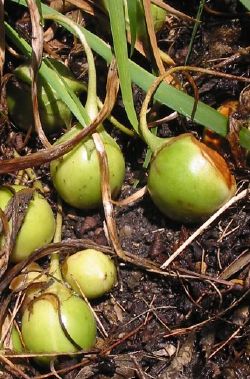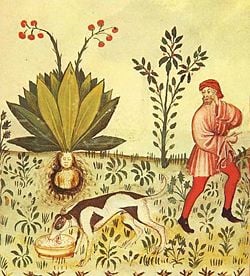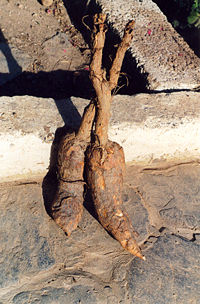Difference between revisions of "Mandrake (plant)" - New World Encyclopedia
Rick Swarts (talk | contribs) |
Rick Swarts (talk | contribs) |
||
| Line 1: | Line 1: | ||
| − | |||
| − | |||
| − | |||
| − | |||
{{Taxobox | {{Taxobox | ||
| name = Mandrake | | name = Mandrake | ||
Revision as of 13:58, 14 November 2008
| Mandrake | ||||||||||||
|---|---|---|---|---|---|---|---|---|---|---|---|---|
 Mandragora officinarum
| ||||||||||||
| Scientific classification | ||||||||||||
| ||||||||||||
|
Mandragora autumnalis |
Mandrake is the common name for members of the plant genus Mandragora belonging to the nightshades family (Solanaceae). Because mandrake contains deliriant hallucinogenic tropane alkaloids such as hyoscyamine and the roots sometimes contain bifurcations causing them to resemble human figures, their roots have long been used in magic rituals, today also in neopagan religions such as Wicca and Germanic revivalism religions such as Odinism. (It is alleged that magicians would form this root into a crude resemblance to the human figure, by pinching a constriction a little below the top, so as to make a kind of head and neck, and twisting off the upper branches except two, which they leave as arms, and the lower, except two, which they leave as legs.)
The mandrake, Mandragora officinarum, is a plant called by the Arabs luffâh, or beid el-jinn ("djinn's eggs"). The parsley-shaped root is often branched. This root gives off at the surface of the ground a rosette of ovate-oblong to ovate, wrinkled, crisp, sinuate-dentate to entire leaves, 6 to 16 inches long, somewhat resembling those of the tobacco-plant. There spring from the neck a number of one-flowered nodding peduncles, bearing whitish-green flowers, nearly 2 inches broad, which produce globular, succulent, orange to red berries, resembling small tomatoes, which ripen in late spring. All parts of the mandrake plant are poisonous. The plant grows natively in southern and central Europe and in lands around the Mediterranean Sea, as well as on Corsica.
Hebrew Bible
In Genesis 30, Reuben, the eldest son of Jacob and Leah finds mandrakes in the field. Rachel, Jacob's second wife, the sister of Leah, is desirous of the mandrakes and she barters with her sister for them. The trade offered by Rachel is for Leah to spend the next night in Jacob's bed. Soon after this Leah, who previously had had four sons but had ceased to become pregnant for a long while then became pregnant once more and gave birth to a son. There are classical Jewish commentaries which suggest that mandrakes help barren women to conceive a child.[citation needed]
Mandrake in Hebrew is דודאים (dûdã'im), meaning “love plant”. Among certain Asian cultures, it is believed to ensure conception. [citation needed] Most interpreters hold Mandragora officinarum to be the plant intended in Genesis 30:14 ("love plant") and Song of Songs 7:13 ("the mandrakes send out their fragrance"). A number of other plants have been suggested such as bramble-berries, Zizyphus Lotus, the sidr of the Arabs, the banana, the lily, the citron, and the fig.
Magic, spells, and witchcraft
According to the legend, when the root is dug up it screams and kills all who hear it. Literature includes complex directions for harvesting a mandrake root in relative safety. For example Josephus (c. 37 C.E. Jerusalem – c. 100) gives the following directions for pulling it up:
A furrow must be dug around the root until its lower part is exposed, then a dog is tied to it, after which the person tying the dog must get away. The dog then endeavours to follow him, and so easily pulls up the root, but dies suddenly instead of his master. After this the root can be handled without fear.
Extract from Chapter XVI, Witchcraft and Spells: Transcendental Magic its Doctrine and Ritual by Eliphas Levi. A Complete Translation of Dogme et Rituel de la Haute Magie by Arthur Edward Waite. 1896
... we will add a few words about mandragores (mandrakes) and androids, which several writers on magic confound with the waxen image; serving the purposes of bewitchment. The natural mandragore is a filamentous root which, more or less, presents as a whole either the figure of a man, or that of the virile members. It is slightly narcotic, and an aphrodisiacal virtue was ascribed to it by the ancients, who represented it as being sought by Thessalian sorcerers for the composition of philtres. Is this root the umbilical vestige of our terrestrial origin ? We dare not seriously affirm it, but all the same it is certain that man came out of the slime of the earth, and his first appearance must have been in the form of a rough sketch. The analogies of nature make this notion necessarily admissible, at least as a possibility. The first men were, in this case, a family of gigantic, sensitive mandragores, animated by the sun, who rooted themselves up from the earth ; this assumption not only does not exclude, but, on the contrary, positively supposes, creative will and the providential co-operation of a first cause, which we have reason to call God.
Some alchemists, impressed by this idea, speculated on the culture of the mandragore, and experimented in the artificial reproduction of a soil sufficiently fruitful and a sun sufficiently active to humanise the said root, and thus create men without the concurrence of the female. (See: Homunculus) Others, who regarded humanity as the synthesis of animals, despaired about vitalising the mandragore, but they crossed monstrous pairs and projected human seed into animal earth, only for the production of shameful crimes and barren deformities. The third method of making the android was by galvanic machinery. One of these almost intelligent automata was attributed to Albertus Magnus, and it is said that St Thomas (Thomas Aquinas) destroyed it with one blow from a stick because he was perplexed by its answers. This story is an allegory; the android was primitive scholasticism, which was broken by the Summa of St Thomas, the daring innovator who first substituted the absolute law of reason for arbitrary divinity, by formulating that axiom which we cannot repeat too often, since it comes from such a master: " A thing is not just because God wills it, but God wills it because it is just.
The real and serious android of the ancients was a secret which they kept hidden from all eyes, and Mesmer was the first who dared to divulge it; it was the extension of the will of the magus into another body, organised and served by an elementary spirit; in more modern and intelligible terms, it was a magnetic subject.
It was a common belief in some countries that a mandrake would grow where the semen of a hanged man dripped on to the earth; this would appear to be the reason for the methods employed by the alchemists who "projected human seed into animal earth". In Germany, the plant is known as the Alraune: the novel (later adapted as a film) Alraune by Hanns Heinz Ewers is based around a soulless woman conceived from a hanged man's semen, the title referring to this myth of the Mandrake's origins.
The following is taken from "Paul Christian". [1] pp. 402-403, The History and Practice of Magic by Paul Christian. 1963:
Would you like to make a Mandragora, as powerful as the homunculus (little man in a bottle) so praised by Paracelsus? Then find a root of the plant called bryony. Take it out of the ground on a Monday (the day of the moon), a little time after the vernal equinox. Cut off the ends of the root and bury it at night in some country churchyard in a dead man's grave. For thirty days water it with cow's milk in which three bats have been drowned. When the thirty-first day arrives, take out the root in the middle of the night and dry it in an oven heated with branches of verbena; then wrap it up in a piece of a dead man's winding-sheet and carry it with you everywhere.
In literature
- In the Bible
In Genesis 30:14, Leah gives Rachel mandrakes in exchange for a night of sleeping with their husband.
- During wheat harvest, Reuben went out into the fields
- and found some mandrake plants,
- which he brought to his mother Leah.
- Rachel said to Leah, "Please
- give me some of your son's mandrakes."
Song of Songs 7:13 KJV
- "The mandrakes send out their fragrance,
- and at our door is every delicacy,
- both new and old,
- that I have stored up for you, my lover."
- Machiavelli wrote a play Mandragola (The Mandrake) in which the plot revolves around the use of a mandrake potion as a ploy to bed a woman.
- Shakespeare refers four times to mandrake and twice under the name of mandragora.
- "...Not poppy, nor mandragora,
- Nor all the drowsy syrups of the world,
- Shall ever medicine thee to that sweet sleep
- Which thou owedst yesterday."
- Shakespeare: Othello III.iii
Aton Re Luven Angel 4 -----
- "Give me to drink mandragora...
- That I might sleep out this great gap of time
- My Antony is away."
- Shakespeare: Antony and Cleopatra I.v
- "Shrieks like mandrakes' torn out of the earth."
- Shakespeare: Romeo and Juliet IV.iii
- "Would curses kill, as doth the mandrake's groan"
- King Henry IV part II III.ii
- Thomas Lovell Beddoes uses the name of mandrake for a character in his play, Death's Jest Book.
- John Webster in The Duchess of Malfi:
- Ferdinand "I have this night digged up a mandrake..."
- John Donne's song:
- "Go and catch a falling star
- Get with child a mandrake root
- Tell me where all past years are,
- Or who cleft the devil's foot..."
- (This poem can be heard set to music by John Renbourn [of Pentangle fame] on his eponymous CD [Transatlantic TRA 135, 1965])
- D. H. Lawrence referred to Mandrake as that "weed of ill-omen".
- Ezra Pound used it as metaphor in his poem "Portrait d'une femme":
- "You are a person of some interest, one comes to you
- And takes strange gain away: [...]
- Pregnant with mandrakes, or with something else
- That might prove useful and yet never proves, [...]"
- Samuel Beckett, in Act I of Waiting for Godot the two attendants discuss hanging themselves and reference is made to the belief that mandrake is seeded by the ejaculation of hanged men.
- In J. K. Rowling's Harry Potter and the Chamber of Secrets, the mandrake root is cultivated by Professor Sprout to cure the petrification of several characters who had looked indirectly into the eyes of the Basilisk; the author makes use of the legend of the mandrake's scream (see above), and anyone tending mandrakes wears earmuffs to dull the sound of the scream, if the plant must be transplanted.
- In Yasuhiro Kanō's manga Mx0, Lucy is a magical mandrake that covertly aids the main character.
- William S. Burroughs' novel Naked Lunch reads "Johnny scream like a mandrake"
- Salman Rushdie's novel The Enchantress of Florence reads "[...] mythical plant the locals called ayïq otï, otherwise known as the mandrake root. The mandrake – or “man-drag-on” [...] screamed when you pulled them up into the air just as human beings would scream if you buried them alive." Then the novel tells a story of boys trying to grow mandrake using hanged archbishop's semen.
In film
- In Pan's Labyrinth, the main character Ofelia places a baby-shaped mandrake root in a bowl of fresh milk under her pregnant mother's bed to cure her mysterious illness.
- In The Serpent's Kiss, Richard E. Grant's character adds powdered mandrake root to Meneer Chrome's (played by Ewan McGregor) snuff box in an attempt to poison him.
- In Harry Potter and the Chamber of Secrets the students have to repot Mandrake seedlings while wearing earmuffs to protect against the deadly screams.
- In Flesh & Blood, the characters Agnes (played by Jennifer Jason Leigh) and Steven (Tom Burlinson) eat the mandrake root in order to fall in love with each other.
- In To Kill a Mockingbird, Scout refers to "half-remembered tales of changelings and mandrake roots."
- In New Tricks, Mandrake root is used to anesthetize dogs that are the victims of a serial killer. It is also in connection with the Egyptian gods Anubis and Wepwawet.
- In Excalibur, Merlin tests Morgana's knowledge of the properties of mandrake.
In video games
- In Castlevania: Aria of Sorrow for Game Boy Advance Mandragora is a root which is pulled from the ground by a skeleton and that attacks with a shriek. In the Nintendo DS sequel, Castlevania: Dawn of Sorrow, Mandragora roots return; here they attack by lifting themselves out of the ground and screaming so loudly that they can explode.
- In the Final Fantasy series, Mandragora was often classified as a plant monster. Its shrieking cries often induced Silence effects.
- Similarly, in the Tales series, this is also a plant monster, but with different effects.
- In the Ultima series, Mandrake roots serve as a rare reagent needed to cast the most powerful spells.
- In The Elder Scrolls IV: Oblivion, Mandrake plants are scattered throughout the game world, and the roots can be harvested for use in alchemy. Mandrake roots provides cure disease, resist poison, damage agility, and fortify willpower effects.
- In Quest for Glory I: So You Want To Be A Hero, the player needs to harvest Mandrake root for Baba Yaga, who makes a mousse out of it to eat.
- In Haunting Ground, the maid Daniella cares for Mandragora in her greenhouse, and taking them will result in them screaming and alerting Daniella.
- Mandragora are a central plot element of the game Sword of the Berserk: Guts' Rage. The plants, which scream when removed from the ground, are able to infect living people, then known as "Mandragorans", with a disease which causes them to become docile when let be, but results in extreme rage and thoughtless acts of murder when provoked enough.
- In Myth: Fallen Lords & Myth II: Soulblighter, the Journeymen (healing units) and later, the Heron Guards, use mandrake roots that can be found on the field of play, to recoup their healing spell ability.
- In Nostale online game, the low level monster called Mandragora is a plant type monster that will make a loud screams that result in status effect HP reduced at the certain percentage for any player that kill it.
- The Pokémon Oddish is based on the mandrake.
ReferencesISBN links support NWE through referral fees
- ↑ pp. 402-403, The History and Practice of Magic by Paul Christian. 1963
- Blakemore, C., and S. Jennett. 2001. The Oxford Companion to the Body. New York: Oxford University Press. ISBN 019852403X.
External links
Template:Herbal Sedatives Template:Ancient anaesthesia-footer
Credits
New World Encyclopedia writers and editors rewrote and completed the Wikipedia article in accordance with New World Encyclopedia standards. This article abides by terms of the Creative Commons CC-by-sa 3.0 License (CC-by-sa), which may be used and disseminated with proper attribution. Credit is due under the terms of this license that can reference both the New World Encyclopedia contributors and the selfless volunteer contributors of the Wikimedia Foundation. To cite this article click here for a list of acceptable citing formats.The history of earlier contributions by wikipedians is accessible to researchers here:
The history of this article since it was imported to New World Encyclopedia:
Note: Some restrictions may apply to use of individual images which are separately licensed.

